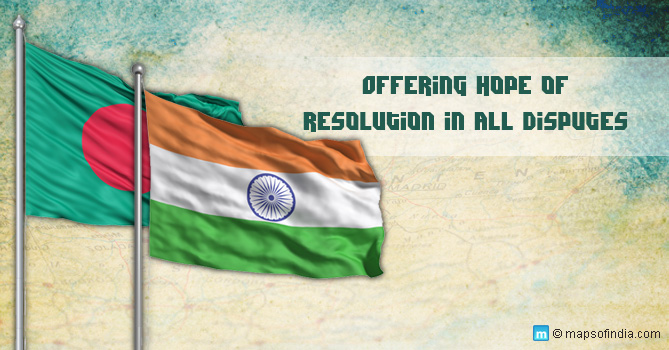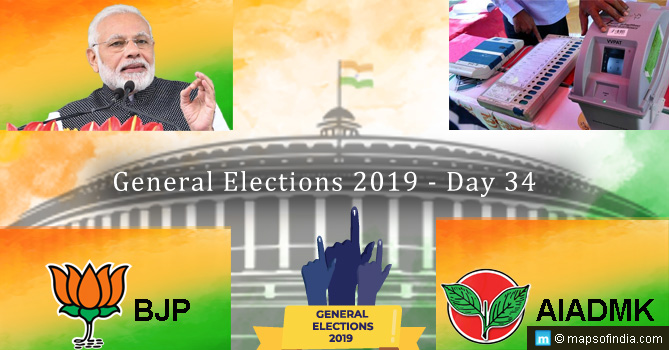
At one minute past midnight on the night of 31 July – 01 August 2015, it will be freedom finally, for the stateless people living in a narrow tract of land between India and Bangladesh. These unfortunate victims of history have lived for 68 years without a national identity, with neither country extending any benefit or services to these people.
An unfortunate fallout of Partition in 1947 was that certain enclaves claimed by Bangladesh remained physically under Indian control, while other enclaves claimed by India remained under Bangladeshi control, but the people residing in these enclaves remained unclaimed by either country. The territorial dispute with erstwhile East Pakistan was extended to Bangladesh when it won its independence in 1971, and finally, in 1974, the Land Border Agreement (LBA) was negotiated between the two countries. But political factors on both sides held back the formal agreement and it was only during Prime Minister Modi’s historic visit to Bangladesh, that the Land Border Agreement (LBA) was formally signed.
Under the LBA, India is to get 111 enclaves comprising 17,160 acres of land, while India will hand over to Bangladesh 51 enclaves comprising 7,110 acres. In order to ensure a smooth transition in an orderly manner, both countries agreed to hold a joint survey in all the 162 disputed enclaves to determine local resident’s choice as to which country they wish to belong, once the enclaves were exchanged.
The exchange of enclaves is not a simple process as many factors have to be sorted out. For instance, what happens to the property of a family that chooses the citizenship of the other country and vice versa? How do they get compensated and at what value? What about those properties where the owner in whose name(s) it is registered, is no more? And then, there may be properties where the land ownership documents are incomplete or vague. How are these to be resolved?
In order to address all these issues, both governments have agreed to give a time of one year i.e. up to 30 June 2016, to ensure all people are able to resolve and settle property matters and shift to their respective countries. The governments on their part are planning to list all properties on a website with relevant information that will help people make the sale and transfer.
Implications of this historic settlement
In the context that India has unresolved land disputes with China and Pakistan, and water resource sharing disagreements with Sri Lanka, this agreement assumes significance from several perspectives.
First, it reflects a new resolve by the present government in India to address legacy issues that have dodged settlement for many years. With the initiative shown by PM Modi in reaching out to the immediate neighbours, right from the time of his government’s swearing-in ceremony and the speed with which he has managed to placate a hostile Chief Minister of West Bengal and bring on board the Chief Minister of another reticent state, Assam, and get them to endorse the LBA, gives out a strong signal that India is willing to sit on the table and resolve legacy differences.
India and China have been to war in 1962 on account of ambiguity and interpretation of the disputed territory, with both sides staking their respective claims. To many this may seem a complex and intractable problem to resolve, but China has had even more complex territorial disputes with Russia which has resulted in frequent hostilities between the two countries, although restricted to the local level. However, China and Russia were able to sit down and resolve the dispute and today the land border is demarcated without ambiguity, to mutual satisfaction. As a result, China today has emerged as Russia’s largest trading partner and the economic relationship is set to grow even further. The message going out is – when there is political will on both sides, resolution of seemingly intractable problems becomes easier.
India’s economic relations with China are deepening, with India becoming a full member of the Shanghai Cooperation Organization (SCO) and the Asian Infrastructure Investment Bank (AIIB). If the two countries could resolve the border dispute based on mutual acceptance, then the resulting impact can have a transformational impact on both countries.
The proposed Military Strike Corp being planned by India to beef up security on the eastern front is likely to cost Rs 60,000 crore. This hugh investment, if deployed in the same region for civilian use, could transform the region forever. The same is true for China, which has been investing heavily in the region, aimed more towards gaining military advantage rather than derive civilian benefit, which should be the case with both governments. However, if both countries were to resolve the land dispute, the potential to use the same physical infrastructure on both sides will only boost the economies of both nations.
On the northern side, Kashmir as a whole has been a point of contention between India and Pakistan, with Jammu and Kashmir remaining with India, and Pakistan Occupied Kashmir falling under Pakistan’s control. However, the local people of entire region of Kashmir, on both sides, have been separated and are continuing to suffer in the absence of a political settlement that is acceptable to all stakeholders.
On the western border, the lifeless marshlands of Sir Creek area has been a point of contention between the two countries. Although, through years of back channel negotiations, both countries had come close to resolving both the problem of Kashmir and Sir Creek on several occasions, vested political interests on both sides vetoed any further progress. Both India and Pakistan have vast potential to transform the entire South Asian region, if only they were to resolve their differences at the earliest through dialogue.
Another area of contention is the sharing of resources at sea between Sri Lanka and India. With fisherman from both sides fishing in what each side perceives as their zone, tensions between the two countries is an impediment to better relations.
It is in the context of all the above mentioned disputes that the India Bangladesh LBA assumes significance, and offers hope of resolution of all disputes in the region, in coming times. India must consolidate and extend its economic cooperation with Bangladesh, so that the resulting benefit to both nations stands as an example to all nations of the region, on the advantages of an early resolution of border dispute.
Tonight, 68 candles will be lit in the houses of each resident of the enclaves on India Bangladesh border, to mark each year in their struggle for freedom. Let this day also be a step to many such candles being lit someday, in all people’s homes, in all disputed territories. It only requires political will.
Read More:
Government–Naga Peace Accord
Bilateral Issues India Needs to Resolve
Nuclear Liability Law: What’s the Big Deal?
Land Acquisition Laws in India and the Duplicitous Deals
How Can India Benefit From Becoming a Member of SCO?
India’s strategic ties with Vietnam on the rise
India’s Foreign Policy Roadmap
Why Modi government is important for China, US





